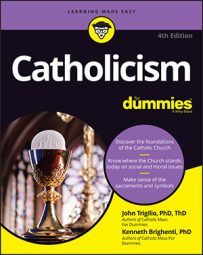The seven sacraments are the most sacred and ancient Catholic rites; they mark the seven major stages of spiritual development:
- Baptism: You are born.
- Holy Eucharist: You are fed.
- Confirmation: You grow.
- Penance: You need healing.
- Anointing of the Sick: You recover.
- Matrimony: You need family.
- Holy Orders: You need leaders.
Catholics belong to their own churches, called parishes, which are local places of worship. The Holy Mass, the Catholic daily and weekly church service, is a reenactment of Holy Thursday (when Jesus celebrated the Last Supper) and Good Friday (when He died to purchase the rewards of eternal life in heaven for humankind).
Sunday attendance at a parish isn't just expected; it's a moral obligation. Not going to Sunday Mass without a worthy excuse, such as illness or bad weather, is considered a grave sin. (Note that many Christians attend church services on Sunday, but Catholics can also attend Mass on Saturday evening instead to fulfill the Sunday requirement.)
Bringing body and soul into the mix
Human beings are created as an essential union of body and soul. Material and spiritual worlds are bridged in each and every human person. Because God made us this way, it only makes sense that both body and soul are incorporated in worship.Attending Mass requires more than just being physically present in church. That's why Catholics use different postures, such as standing, sitting, kneeling, and bowing, and do plenty of listening, singing, and responding to phrases. For example, if the priest says, "The Lord be with you," Catholics respond, "And with your spirit."
During Mass, the inspired Word of God is read, proclaimed, and heard through people's eyes, lips, and ears. Holy Communion, food for the soul, is given to believers.
Sacred art adorns the worship space (such as stained glass, statues, icons, paintings, mosaics, tapestries, and frescoes), sacred music is played and sung, bells are rung, incense is burned . . . the senses are stimulated as body and soul are united and nourished in the House of God.
Participating inside and out
Catholics are not spectators while at public worship. Yes, there is a distinction between the clergy (ordained ministers who perform the sacred rites and rituals in the name of the Church) and the congregants, but the people in the pews are crucial because they represent the entire human race.Everyone in the church is asked to get involved in sacred liturgy. Divine worship is the adoration of God by man, and interior participation is the most important element. Every person at Mass should be open to God's grace to accept and cooperate with it. Interior participation means going to church not for what you get out of it but for what you can give to God.
Of all the sacraments and all the sacred liturgies, the Mass is par excellence, the source and summit of Christian worship. It is more than a mere reenactment of the Last Supper; it is the unbloody re-presentation of Christ's sacrifice on Calvary (Good Friday).
Mass is first and foremost sacred worship, but it also teaches and supports what Catholics believe in terms of the doctrines and dogmas that form the creed of the religion. Mass communicates religious truths and encourages parishioners to respond morally and spiritually by living holy lives.

